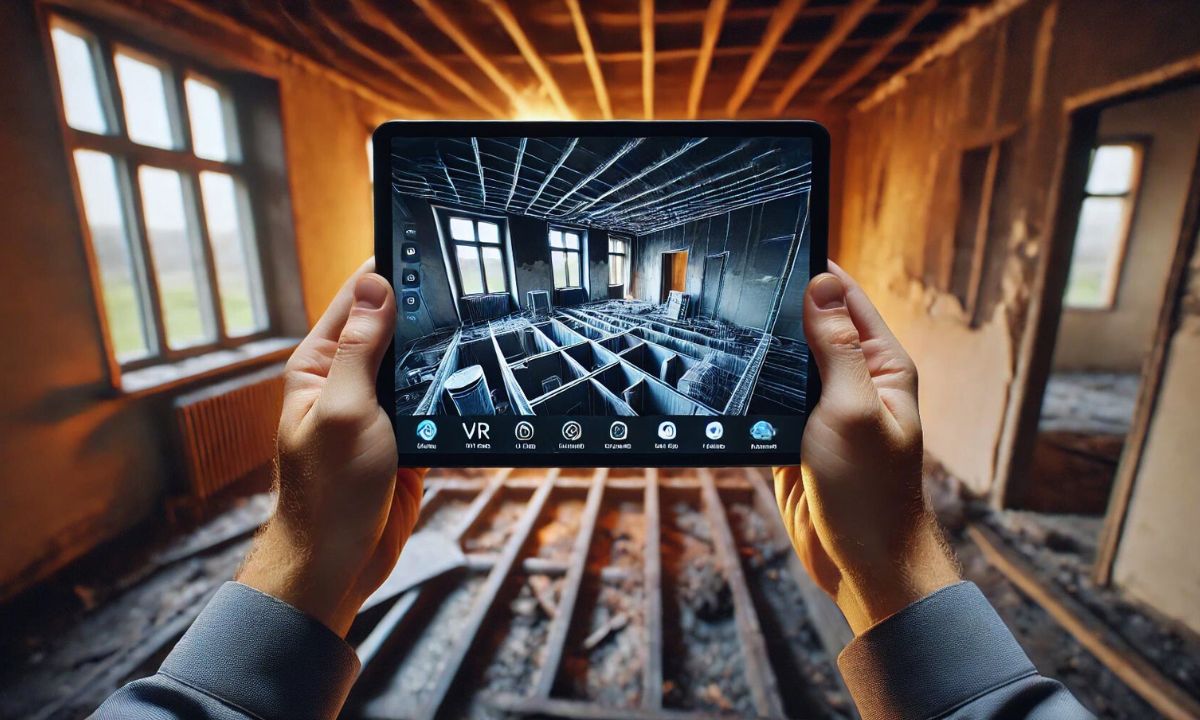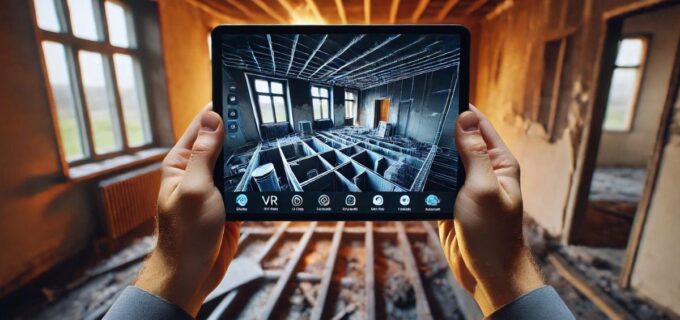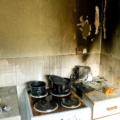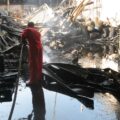
Singapore’s skyline is a testament to urban ingenuity, but with incredible architectural feats come unique challenges. The aftermath can be devastating when a fire strikes in this densely packed metropolis. Smoke-stained high-rises, water-logged apartments, and the acrid scent of burnt materials are just the beginning of a complex restoration process.
Enter the era of smart technology in fire damage restoration. The industry is undergoing a high-tech revolution, from IoT sensors that detect hidden moisture to AI-powered damage assessment tools. These innovations are not just gadgets; they’re game-changers in how we approach fire damage restoration in urban environments.
Adopting these modern technologies is no longer a luxury—it’s necessary for effective restoration in Singapore’s unique urban landscape. Smart tech offers faster response times, more accurate assessments, and a quicker return to normalcy for affected residents and businesses.
In this post, we’ll explore how cutting-edge technology transforms fire damage restoration in Singapore, making the process smarter, faster, and more efficient than ever before. Join us as we delve into the future of urban disaster recovery, where silicon meets soot and algorithms tackle ashes.
Understanding Fire Damage Restoration
What is Fire Damage Restoration?
Depending on the scale of the fire, most of the house is often compromised. In this case, fire damage restoration becomes crucial to rehabilitate the house back to its condition before the tragedy. Restoring a property after it undergoes fire damage is essential, as not doing so can harm the resident’s physical and mental health and damage the property’s interior structure.
How Can Fire Damage Affect One’s Physical Health?
Prolonged exposure to fire damage can adversely affect one’s physical health and make even the strongest man weak and frail. Some of the most common side effects include:
Respiratory Effects
- Short-term: Coughing, shortness of breath from smoke inhalation
- Long-term: Potential for chronic conditions like asthma or bronchitis
Skin Injuries
- Burns: Ranging from minor to severe, requiring medical attention
- Possible irritation from contact with chemicals released in fires
Cardiovascular Concerns
- Increased heart rate and blood pressure due to stress
- Potential complications for those with pre-existing heart conditions
Eye Irritation
- Redness, watering, and discomfort from smoke exposure
- Risk of more serious damage in severe cases
General Health
- Weakened immune system from exposure to toxic substances
- Possible long-term health effects from prolonged exposure
Therefore, one must call professionals to clean up the aftermath of a fire to prevent any long-term health impacts. Professionals have access to more advanced technologies and know the correct techniques to restore a property to its pristine condition.
The Emergence of Smart Technology in Restoration
Smart technology in fire damage restoration represents a paradigm shift in how professionals approach and execute their work. It encompasses advanced tools and systems that leverage connectivity, data analysis, and artificial intelligence to revolutionize restoration.
At its core, smart technology in this field integrates computing and telecommunication capabilities into traditional restoration equipment and processes. This integration enables devices to communicate with each other and centralized systems, facilitating automated functionality and remote accessibility. This translates to enhanced efficiency, accuracy, and client satisfaction for restoration contractors.
Overview of Different Types of Smart Technologies Used in Restoration
Internet of Things (IoT)
- Smart Sensors: IoT-enabled sensors can be placed throughout a damaged property to monitor real-time conditions. These sensors detect changes in structural integrity, temperature, humidity, and the presence of hazardous substances, providing critical data that informs restoration strategies.
- Connected Devices: Devices such as smart thermostats, air purifiers, and dehumidifiers can be remotely controlled and monitored, ensuring optimal conditions for restoration and preventing further damage.
- Advantages: IoT technology provides more comprehensive coverage, faster response times, and allows fires to be monitored remotely using real-time data. Additionally, it can be easily integrated with Building Automation Systems (BAS), enabling building management to facilitate coordinated responses and initiate evacuation procedures.
- Disadvantages: While it offers significant potential to improve fire safety, it is also vulnerable to cybersecurity attacks due to its low data security and can be extremely costly initially to install. Besides this, its biggest weakness is that most IoT devices rely heavily on internet connectivity and power supply, which is often disrupted during large fires, rendering the product inoperable.
Artificial Intelligence (AI)
- Damage Assessment Tools: AI-powered software can analyze data from sensors, drones, and other sources for detailed and accurate damage assessments. These tools can identify the extent of structural damage, predict areas of concern, and recommend the most effective restoration methods.
- Predictive Analytics: Machine learning algorithms can analyze historical data and current conditions to forecast damage progression, estimate restoration timelines, and optimize resource allocation.
- Advantages: AI can analyze data quickly to provide detailed assessments of fire damage and predict damage progression, restoration timelines, and resource needs, enhancing planning and efficiency. It can also automate routine tasks, reducing the need for manual intervention.
- Disadvantages: Maintaining AI systems can become costly, AI’s effectiveness depends on the quality of the available data, and implementing AI requires specialized knowledge and expertise.
Drones and Robotics
- Aerial Drones: High-resolution cameras and thermal imaging sensors can survey fire-damaged sites from above, capturing detailed images and data. This aerial perspective allows for thorough inspections of roofs, upper floors, and other hard-to-reach areas without risking human safety.
- Ground Robotics: Robotic devices can navigate through debris and unstable structures, performing tasks such as debris removal, structural assessments, and targeted clean-up. These robots can access areas that may be too dangerous for human workers, enhancing safety and efficiency.
- Advantages: It provides workers with a comprehensive view of the situation without risking their lives, saving firefighters time and increasing efficiency. It is also highly versatile as it can be equipped with various sensors and tools to perform multiple tasks.
- Disadvantages: Drone acquisition can be expensive, is subject to regulatory restrictions, and may have technical limitations, such as navigating complex environments or handling delicate materials.
3D Imaging and Virtual Reality (VR)
- 3D Scanning: Advanced imaging technologies can create detailed 3D models of damaged structures. These models provide a comprehensive site view, aiding in precise planning, documentation, and stakeholder communication.
- Virtual Reality (VR): VR technology enables restoration professionals to visualize the entire restoration project in a virtual environment. This capability is helpful for planning, training, and demonstrating restoration plans to clients and insurers.
- Advantages: it provides a detailed visualization of damaged structures, enhancing communication between clients and the stakeholders as they can understand the extent of the damage, and is valuable in training
- Disadvantages: it can become costly, requires high technical skills, and may need help integrating it into an existing system.
Benefits of Integrating Smart Technology in Restoration Projects
- Accelerated assessment and restoration processes: Enables faster project completion, reducing disruption to affected individuals and businesses.
- Enhanced precision in damage evaluation and planning: Minimises overlooked issues, ensuring more thorough and effective restoration.
- Long-term financial savings: Optimises resource allocation, leading to reduced waste and labor expenses.
- Improved safety measures: Reduces risk to human workers by utilizing robotics in hazardous environments.
- Environmentally conscious practices: Supports sustainability goals through efficient resource use and reduced energy consumption.
- Advanced stakeholder communication: Facilitates better understanding and collaboration among all parties involved in the restoration process.
- Comprehensive documentation and reporting: Ensures regulatory compliance and provides transparency for insurance claims and dispute resolution.
Challenges faced when integrating innovative technologies in restoration projects
- Initial Costs: High upfront investment for purchasing and installing smart technology.
- Training and Expertise: Need specialized skills and training to operate and maintain advanced technologies.
- Data Security: Ensuring data protection and cybersecurity for connected devices and systems.
- Regulatory Compliance: Navigating regulatory requirements and obtaining necessary permits, especially for drones.
- Technical Integration: Integrating new technologies with existing systems and processes can be complex.
- Reliability Concerns: Dependence on internet connectivity and power supply, which can be disrupted during emergencies.
- Data Quality: Ensuring the accuracy and completeness of data collected by smart devices.
- Environmental Factors: Adapting technologies to function effectively in various environmental conditions encountered during restoration.
Future Prospects
Emerging Technologies and Innovations
Advanced AI and Machine Learning
- Predictive Maintenance: Enhanced AI will anticipate potential structural failures, allowing proactive measures to be taken.
- Improved Decision-Making: More sophisticated AI will offer precise recommendations for restoration strategies, materials, and timelines.
Improved Robotics
- Autonomous Drones and Robots: Fully autonomous drones and robots will revolutionize inspections and restoration tasks with minimal human intervention.
- Advanced Capabilities: Future robots will perform various tasks, from precise demolition to intricate repairs.
Enhanced IoT and Smart Sensors
- Next-Generation Sensors: Advanced IoT sensors will provide detailed, real-time data on air quality, structural integrity, and environmental conditions.
- Smart Building Integration: Seamless integration with building management systems for continuous monitoring and automatic response.
Augmented Reality (AR) and Virtual Reality (VR)
- Training and Planning: AR and VR will provide realistic simulations for better training and effective response strategies.
- Client Engagement: Virtual walkthroughs will enhance communication and satisfaction by showing restoration plans and progress.
Potential Applications and Benefits
- Dynamic Restoration Plans: Real-time data will enable adaptive restoration processes based on ongoing assessments.
- Enhanced Efficiency: Immediate data access will streamline decision-making and improve restoration speed and accuracy.
The future of fire damage restoration in Singapore looks promising with the continued advancement and integration of intelligent technologies, offering more efficient, safe, and cost-effective solutions.
How Smart Technologies are Transforming Fire Damage Restoration in Singapore
Integrating smart technologies is revolutionizing fire damage restoration in Singapore’s unique urban landscape. As we’ve explored, these innovations offer significant advantages, from IoT-enabled real-time monitoring to AI-powered damage assessments, drone-assisted inspections, and immersive 3D visualizations.
While each technology presents its challenges—initial costs, data security concerns, or regulatory hurdles—the potential benefits in efficiency, accuracy, safety, and sustainability are undeniable, the key lies in strategically balancing these cutting-edge solutions with practical considerations.
As Singapore evolves architecturally, so must our approach to fire damage restoration. Professionals in this field are encouraged to stay abreast of technological advancements, continuously upgrading their skills and knowledge. By embracing these innovative technologies judiciously, restoration experts can enhance their capabilities, ultimately providing faster, safer, and more effective services to those affected by fire damage.
The future of fire damage restoration in Singapore is intrinsically linked to the thoughtful integration of intelligent technology. As we move forward, those who successfully navigate this high-tech landscape will lead the industry and contribute significantly to the resilience and recovery of our urban environment in the face of fire-related challenges.
Ready to experience the benefits of advanced fire damage restoration solutions? Contact Big Red Singapore today for expert restoration services that incorporate the latest smart technologies. Call us at 6241 9443 or send a WhatsApp message to +65 9321 9321. Let Big Red Singapore help you restore your property efficiently, safely, and effectively with cutting-edge solutions.




